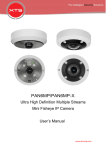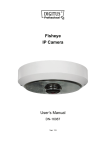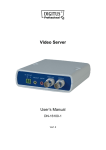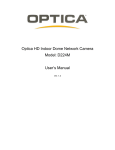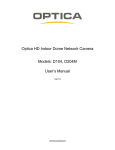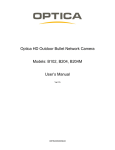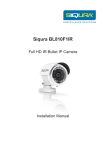Download Full HD WDR Mini Bullet IP Camera
Transcript
Full HD WDR Mini Bullet IP Camera User’s Manual DN-16083-1 Ver. 1.0 Table of Contents 1. 2. Overview .................................................................................................................................. 2 1.1 Features ........................................................................................................................ 2 1.2 Package Contents ......................................................................................................... 3 1.3 Dimensions.................................................................................................................... 4 1.4 Function Cables ............................................................................................................ 5 1.6 microSD Card Slot / Default Button ............................................................................... 6 Camera Cabling....................................................................................................................... 7 2.1 Power Connection ......................................................................................................... 7 2.2 Ethernet Cable Connection ........................................................................................... 7 2.4 Waterproof Cable Connector......................................................................................... 8 3. System Requirements ............................................................................................................ 9 4. Access Camera ..................................................................................................................... 10 5. Setup Video Resolution ........................................................................................................ 13 6. Configuration Files Export / Import ..................................................................................... 14 7. Tech Support Information .................................................................................................... 15 7.1 Delete the Existing Viewer .......................................................................................... 15 7.2 Setup Internet Security ................................................................................................ 16 Appendix: Technical Specifications 1 1. Overview DN-16083-1 supports both H.264 and MJPEG standard. The H.264 encoder performance is up to 1080P at 60 fps. Also, the camera can supply dual full HD 1080P real-time streaming. With more computing power, the camera could provide more flexibility for users and system managers. The camera also supports shutter WDR function, which can provide better image quality under extreme light contrast scenarios or light changing environments. 1.1 2 Features Sony Progressive Scan CMOS Sensor 1.3M / 2M Resolution Quad Streams Support Dual Streams- Full HD 1080P Real-time + Full HD 1080P Real-time Dual Stream Compression- H.264 Baseline / Main / High Profile + MJPEG Multi-language Support Smart Event FunctionMotion Detection / Network Failure Detection / Tampering Alarm / Periodical Event / Manual Trigger / Face Detection / Audio Detection Ultra Dynamic Range Privacy Masks 3D Noise Reduction / 2D Noise Reduction Smart IR Mode Day / Night (ICR) IR LED Module Digital Image Stabilization (DIS) Weatherproof (IP66 International) microSD Support ONVIF Support 1.2 Package Contents Please check the package containing the following items listed below. Outdoor with Vari-Focal Lens Full HD WDR Mini Bullet IP Camera with Vari-Focal Lens Self-Tapping Screw Plastic Screw Anchor (x5) (x5) CD Quick Guide (bundled software and documentation) NOTE: The supplied self-tapping screws are for soft substances / materials such as wood. For other installation environments such as cement wall, it is required to pre-drill and use plastic anchors before fastening the supplied self-tapping screws on the wall. 3 1.3 Dimensions The dimensions of the camera are shown below. Outdoor with Vari-Focal Lens 4 1.4 Function Cables IP66 RJ-45 Cable Pin Definition No. 1 Connector RJ-45 Definition For network and PoE connection 5 1.6 microSD Card Slot / Default Button The positions of the microSD card slot and the default button are shown as below. Fixed Lens Mini Vari-Focal Lens Vari-Focal Lens microSD Card Slot Insert the microSD card into the card slot to store videos and snapshots. Do not remove the microSD card when the camera is powered on. NOTE: It is not recommended to record with the microSD card for 24/7 continuously, as it may not be able to support long term continuous data read/write. Please contact the manufacturer of the microSD card for information regarding the reliability and the life expectancy. Default Button Press the button with a proper tool for at least 20 seconds to restore the system. 6 2. Camera Cabling Before users connect cables, make sure that all cables and the power adaptor are placed in dry and well-waterproofed environments, e.g. waterproof boxes. The purpose is to prevent moisture accumulation inside the camera and moisture penetration into cables, which might lead to camera breakdown. Please follow the instructions below to complete camera connection. 2.1 Power Connection For power connection, please power the camera by PoE with a Power Sourcing Equipment (PSE) switch. Refer to the section below for Ethernet cable connection. NOTE: If PoE is used, make sure PSE is in use in the network. 2.2 Ethernet Cable Connection For best transmission quality, cable length shall not exceed 100 meters. Connect one end of the Ethernet cable to the RJ-45 connector of the camera, and plug the other end of the cable to the network switch or PC. NOTE: In some cases, Ethernet crossover cable might be needed when connecting the IP camera directly to the PC. Check the status of the link indicator and the activity indicator LEDs. If the LEDs are unlit, please check the LAN connection. Green Link Light indicates good network connection. Orange Activity Light flashes for network activity indication. 7 2.4 Waterproof Cable Connector Follow the instruction below to waterproof the connectors of different types of cables. The supported cables are as shown below. IP66 RJ-45 Cable IP66 RJ-45 Cable For IP66 RJ-45 cable, please use an RJ-45 IP66 plug for connection to prevent water damage. Follow the steps below for cable connection. Step 1: Take out the supplied connector from the RJ-45 IP66 plug. Loosen the thread-lock sealing nut on the RJ-45 IP66 plug. Then thread the Ethernet cable through the thread-lock sealing nut and the RJ-45 IP66 plug. If the Ethernet cable is attached to a connector already, please remove it first. Step 2: Carefully remove a section of rubber coating from the end of the Ethernet cable to reveal the wires. Inset the wires to the correct pins of the connector. Plug the Ethernet cable to the connector of IP66 RJ-45 cable. Step 3: Fasten the RJ-45 IP66 plug to the connector of the IP66 RJ-45 cable. Lastly, tighten the thread-lock sealing nut to the plug. 8 3. System Requirements To perform the IP camera via web browser, please ensure the PC is in good network connection, and meet system requirements as described below. Items System Requirement 1. Intel® Pentium® M, 2.16 GHz or Personal Computer Intel® CoreTM2 Duo, 2.0 GHz 2. 2 GB RAM or more Operating System Windows VISTA / Windows XP / Windows 7 Web Browser Microsoft Internet Explorer 6.0 or later Firefox Chrome Safari Network Card Viewer 10Base-T (10 Mbps), 100Base-TX (100 Mbps) or 1000Base-T (1000 Mbps) operation ActiveX control plug-in for Microsoft IE 9 4. Access Camera For initial access to the camera, users can search the camera through the installer program: DeviceSearch.exe, which can be found in “Device Search” folder in the supplied CD. Accessing the Camera by Device Search Software Step 1: Double click on the program Device Search.exe. Step 2: After its window appears, click on the <Device Search> button on the top. All the finding IP devices will be listed in the page. Step 3: Find the camera in the list by its IP address and click on it. The default IP address of the camera is: 192.168.0.250. Step 4: The default IP address of the camera may not be in the same LAN as the IP address of the PC. If so, the IP address of the camera needs to be changed. Right click on the camera and click <Network Setup>. Meanwhile, record the MAC address of the camera, for future identification. Step 5: The <Network Setup> page will come out. Select <DHCP> and click <Apply> down the page. The camera will be assigned with a new IP address. Step 6: Click <OK> on the Note of setting change. Wait for one minute to re-search the camera. Step 7: Click on the <Device Search> button to re-search all the devices. Find the camera in the list by its MAC address. Then double click or right click and select <Browse> to access the camera directly via a web browser. 10 Step 8: A prompt window requesting for default username and password will appear. Enter the default username and password shown below to login to the camera. Login ID Password admin admin NOTE: ID and password are case sensitive. NOTE: It is strongly advised that administrator’s password be altered for the security concerns. Refer to the Camera’s Web UI Manual in the supplied CD for further details. Installing Viewer Software Online For the initial access to the IP camera, a client program, Viewer, will be automatically installed to the PC when connecting to the camera. If the web browser doesn’t allow Viewer installation, please check the Internet security settings or ActiveX controls and plug-ins settings (refer to section Setup Internet Security) to continue the process. The Information Bar (just below the URL bar) may come out and ask for permission to install the ActiveX Control for displaying video in browser. Right click on the Information Bar and select <Install ActiveX Control…> to allow the installation. Then the security warning window will pop up. Click on <Install> to carry on the software installation. The download procedure of Viewer software is specified as follows. Step 1: In the Viewer installation window, click on <Next> to start the installation. Step 2: A status bar will be displayed to show the installation progress. After the installation is completed, click on <Finish> to exit the installation process. Step 3: Click on <Finish> to close the Viewer installation page. 11 Once the Viewer is successfully installed, the Home page of the IP camera will be displayed as the figure below. NOTE: For more details about the function buttons on the Home page, please refer to the Camera’s Web UI Manual in the supplied CD. 12 5. Setup Video Resolution Users can setup video resolution on Video Format page of the user-friendly browser-based configuration interface. Video Format can be found under this path: Streaming> Video Format. The default values of video resolution are as below. 1.3M H.264- 1280 x 720 (25/30 fps) + H.264- 1280 x 720 (25/30 fps) 2M H.264- 1920 x 1080 (25/30 fps) + H.264- 720 x 576 (25 fps) / H.264- 720 x 480 (30 fps) H.264- 1920 x 1080 (25/30 fps) + H.264- 640 x 480 (25/30 fps) For more details about the combinations of video resolution, please refer to the Camera Web UI Manual in the supplied CD. 13 6. Configuration Files Export / Import To export / import configuration files, users can access the Maintenance page on the user-friendly browser-based configuration interface. The Maintenance setting can be found under this path: System> Maintenance. Users can export configuration files to a specified location and retrieve data by uploading an existing configuration file to the camera. It is especially convenient to make multiple cameras having the same configuration. Export Users can save the system settings by exporting the configuration file (.bin) to a specified location for future use. Click on the <Export> button, and the pop up File Download window will come out. Click on <Save> and specify a desired location for saving the configuration file. Upload To upload a configuration file to the camera, please first click on <Browse> to select the configuration file, and then click on the <Upload> button for uploading. 14 7. Tech Support Information This chapter will introduce how to delete previously-installed Viewer in the PC and how to setup the Internet security. 7.1 Delete the Existing Viewer For users who have installed Viewer in the PC previously, please remove the existing Viewer before accessing the IP camera. Deleting the Viewer Activate the <Control Panel>, and then double click on <Add or Remove Programs>. In the <Currently installed programs> list, select <Viewer> and click on <Remove> to uninstall the existing Viewer. Deleting Temporary Internet Files To improve browser performance, it is suggested to clean up all the files in the <Temporary Internet Files>. The procedure is as follows. Step 1: In the web browser, click on the <Tools> tab on the menu bar and select <Internet Options>. Step 2: Click on the <Delete> button under <Browsing history> section. Then tick the box beside the <Temporary Internet Files>. Step 3: Click on <Delete> to start deleting the files. 15 7.2 Setup Internet Security If ActiveX control installation is blocked, please either set Internet security level to default or change ActiveX controls and plug-ins settings. Internet Security Level: Default Step 1: Start the Internet Explorer (IE). Step 2: Click on the <Tools> tab on the menu bar and select <Internet Options>. Step 3: Click on the <Security> tab, and select <Internet> zone. Step 4: Down the page, click on the <Default Level> button, and click on <OK> to confirm the setting. Close the browser window, and restart a new one later to access the IP camera. ActiveX Controls and Plug-ins Settings Step 1: Repeat Step 1 to Step 3 of the previous section above. Step 2: Down the page, click on the <Custom Level> button to change ActiveX controls and plug-ins settings. The Security Settings window will pop up. Step 3: Under <ActiveX controls and plug-ins>, set ALL items (as listed below) to <Enable> or <Prompt>. Please note that the items vary by IE version. ActiveX controls and plug-ins settings: 1. Binary and script behaviors. 2. Download signed ActiveX controls. 3. Download unsigned ActiveX controls. 4. Allow previously unused ActiveX controls to run without prompt. 5. Allow Scriptlets. 6. Automatic prompting for ActiveX controls. 7. Initialize and script ActiveX controls not marked as safe for scripting. 8. Run ActiveX controls and plug-ins. 9. Only allow approved domains to use ActiveX without prompt. 10. Script ActiveX controls marked safe for scripting*. 11. Display video and animation on a webpage that does not use external media player. Step 4: Click on <OK> to accept the settings. Then there will be a prompt window for confirming the setting changes, click <Yes(Y)> and close the Security Settings window. Step 5: Click on <OK> to close the Internet Options screen. Step 6: Close the browser window, and restart a new one later to access the IP camera. 16

















